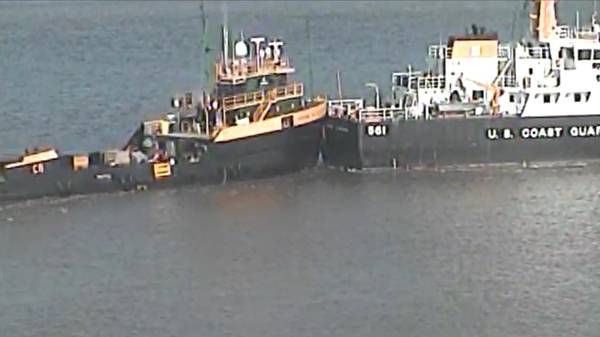
An offshore supply vessel captain’s assumption and poor communication led to a collision with a U.S. Coast Guard cutter in Sabine Pass, a waterway between Texas and Louisiana, the National Transportation Safety Board (NTSB) found.
The NTSB on Thursday released its report detailing its investigation into the October 11, 2020, collision between the offshore supply vessel (OSV) Cheramie Bo-Truc No. 33 and the Coast Guard cutter Harry Claiborne. The Cheramie Bo Truc No. 33 was traveling outbound for sea in Sabine Pass when it collided with the Harry Claiborne near Texas Point, Texas. The Cheramie Bo-Truc No. 33 subsequently ran aground. The crew attempted to refloat the vessel, and as it broke free, the current set the OSV into the stationary cutter, resulting in a second collision. Three crewmembers aboard the Harry Claiborne suffered minor injuries. Damages for the two vessels totaled $505,951, including $440,879 in damages to the Harry Claiborne and $65,072 in damages to the Cheramie Bo Truc No. 33.
Two days prior to the collision, Hurricane Delta impacted the area and caused several buoys in Sabine Pass to move from their assigned locations. At the time of the collision, the Harry Claiborne was servicing buoys impacted by the hurricane. The captain of the Cheramie Bo-Truc No. 33 called the Harry Claiborne by VHF radio requesting to overtake the cutter on the cutter's starboard side. The captain told investigators that he “didn't realize that the buoy was on location" and thereby assumed the cutter was servicing a buoy that had moved into the channel. As the Cheramie Bo-Truc No. 33 was attempting to overtake the cutter, the depth sounder quickly dropped, and the captain aborted his attempt to pass in an effort to avoid running aground. Despite the captain's efforts, the Cheramie Bo-Truc No. 33 collided with the cutter. Two crewmembers on the Harry Claiborne sustained minor injuries. The OSV then grounded in the mud alongside the channel.
The crew of the Cheramie Bo-Truc No. 33 informed the Coast Guard Vessel Traffic Service (VTS) of their plans to refloat the vessel and get under way; however, they did not communicate their plans to the crew of the Harry Claiborne. The crew worked for 45 minutes to get the vessel out of the mud. As they attempted to maneuver around the cutter's stern, the Cheramie Bo-Truc No. 33's starboard bow struck the Harry Claiborne's starboard quarter. A Coast Guard crewmember sustained minor injuries.
The NTSB determined the probable cause of the initial collision was the OSV captain's assumption of the stationary cutter's position, which led to his decision to pass the vessel outside the channel, resulting in a late maneuver toward the Harry Claiborne to avoid running aground. Contributing to the collision was the cutter crew not questioning the passing arrangement proposed by the OSV captain. Causing a second collision was the lack of coordination and communication between the two vessel operators when the Cheramie Bo‑Truc No. 33 crew refloated their vessel.